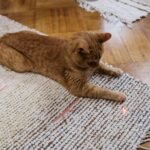Have you ever wondered what goes on in your cat’s mysterious mind as they curl up on your bed, stretch lazily on the windowsill, or dash excitedly around your home? For cat lovers everywhere, the happiness of our feline friends is more than just a hope—it’s a heartfelt mission. But how can you tell if your cat truly feels safe, secure, and loved in their environment? The answer isn’t always found in purrs or tail wags. Sometimes, it’s hidden in subtle behaviors and quiet routines. Let’s explore the clear, heartwarming signs that you’ve built an emotionally safe haven for your beloved cat.
Your Cat Greets You Willingly

One of the most touching signs that your cat feels emotionally secure is their eagerness to greet you when you come home. Whether it’s a gentle meow, a slow blink, or a casual stroll toward the door, these greetings reveal trust and affection. Unlike dogs, cats don’t greet everyone; they reserve this honor for those who make them feel safe. If your cat approaches you without fear or hesitation, it’s a sure sign they see your presence as comforting. Sometimes, your cat may even bring you a “gift”—like a favorite toy—or rub against your legs, marking you with their scent. These small greetings can make even the toughest day feel brighter, and they show your cat’s deep sense of belonging in your home.
Relaxed, Open Body Language

A cat’s body language speaks volumes about their emotional state. In a safe and loving home, your cat might lounge on their back, stretch out fully, or even expose their belly—a vulnerable position that signals complete trust. You’ll notice soft eyes, gentle purring, and a tail that flicks contentedly rather than bristling with fear. Ears will be relaxed and facing forward, not flattened against their head. When your cat feels emotionally secure, their movements are slow and unhurried, not tense or jumpy. This relaxed posture is a silent thank-you for the safe space you’ve created, and it’s one of the most honest compliments a cat can give.
Willingness to Play and Explore

Cats are naturally curious, but they only indulge this curiosity when they feel secure. If your cat confidently explores every nook and cranny of your home, chases after toys, and invents their own games, it’s a clear sign they are emotionally comfortable. Playful behavior—like pouncing, batting at string, or chasing shadows—shows that your cat’s mind is at ease and free from anxiety. Even older cats, who might not zoom around like kittens, will play with their favorite toys or engage in gentle swatting sessions if they feel safe. Your encouragement and participation in playtime further strengthen the bond, making your cat’s environment even more inviting.
Consistent Eating and Grooming Habits

Routine is everything for cats. When your feline friend eats regularly, keeps up with their grooming, and visits the litter box without issue, it’s a strong indication that they feel safe at home. Cats who are stressed or uncomfortable often lose their appetite, neglect grooming, or develop erratic bathroom habits. You might notice your cat cleaning themselves contentedly after a meal or giving themselves a full-body wash in the sunlight. These actions are not just about hygiene—they’re a sign that your cat feels secure enough to care for themselves without fear of sudden threats.
Seeking Out Your Company

If your cat chooses to be near you—whether it’s curling up beside you on the couch, sitting by your feet, or following you from room to room—it’s a heartwarming sign of trust. Unlike more independent cats who keep their distance, a cat who seeks your presence sees you as a source of safety and comfort. Sometimes, your cat may quietly join you during your daily routines, like watching you cook or working beside you at your desk. This companionship, even in silence, is a testament to the emotional security you’ve provided.
Gentle Vocalizations and Communication

Cats communicate with their humans in a variety of ways, and the tone of their meows or trills can tell you everything about their emotional state. In a safe home, your cat’s vocalizations are soft, pleasant, and inviting. You may hear gentle chirps when they want attention or soft purring when they’re being petted. Loud, distressed yowling or persistent hiding is a sign of discomfort, but a cat who communicates calmly is showing that they feel understood and secure. Responding to these gentle sounds fosters even more trust and makes your cat feel truly heard.
Comfortable Sleep in Open Spaces

Cats are predators by nature, but they’re also prey—so their sleeping habits reveal a lot about how secure they feel. If your cat chooses to nap in open, visible areas—like the middle of the sofa, on your bed, or even sprawled across the living room floor—it’s a huge compliment. It means they trust that their environment is free from danger. A cat who feels threatened will hide away in closets or under beds, but a confident cat will sleep wherever they please. Watching your cat snooze peacefully in the open is one of the clearest signs that they believe your home is truly their sanctuary.
Positive Interactions with Other Pets

If you have more than one animal at home, harmony is a key indicator of emotional safety. Cats who feel secure will calmly coexist with other pets, sometimes even forming close bonds. You might see your cat grooming a canine companion, snuggling up with another feline, or playing gentle games together. Occasional spats are normal, but consistent aggression or hiding is not. When your cat greets other pets with curiosity or indifference—rather than fear—it’s a sign that they trust both their environment and your ability to keep the peace.
Slow Blinks and Affectionate Head Butts

Slow blinking is often called a “cat kiss.” When your cat looks at you and slowly closes their eyes, they’re showing deep trust and affection. This simple gesture is a way for cats to say, “I feel safe with you.” Head butting, or “bunting,” is another sweet sign of love. When your cat presses their head gently against you, they’re marking you with their scent and claiming you as part of their family. These little displays of affection may seem subtle, but they’re powerful signs that your cat feels emotionally at home.
Minimal Signs of Stress or Anxiety

An emotionally safe cat rarely shows signs of stress, such as excessive hiding, destructive scratching, or over-grooming. Instead, your cat will move confidently through your home, showing curiosity rather than fear. You won’t see constant tail flicking, flattened ears, or dilated pupils. If your cat occasionally startles but quickly recovers, it means they trust their environment to be forgiving and free from threats. A calm, composed cat is a living testament to the safe space you’ve created.
Willingness to Accept Touch and Handling

A cat that welcomes petting, brushing, or even gentle handling is a cat that feels safe in your hands. They may nuzzle your hand, flop over for belly rubs, or purr contentedly when you stroke their fur. If your cat allows you to trim their nails, check their ears, or even pick them up without fuss, it’s a sign that they trust you completely. They know you’ll respect their boundaries and never cause them harm, which is one of the highest forms of feline approval.
Returning After Exploring Outdoors

If your cat spends time outside—on a leash, in a secure garden, or even just on the balcony—their willingness to return home is a powerful sign of emotional safety. They see your home as a safe base, a place of comfort and security. When they come back after an adventure, looking content and happy, it’s because they know they’re returning to a loving, protective environment. Their loyalty speaks volumes, showing that your home is truly their chosen haven.

Linnea is a born and bred Swede but spends as much time as possible in Cape Town, South Africa. This is mainly due to Cape Town’s extraordinary scenery, wildlife, and atmosphere (in other words, because Cape Town is heaven on earth.) That being said, Sweden’s majestic forests forever hold a special place in her heart. Linnea spends as much time as she can close to the ocean collecting sea shells or in the park admiring puppies.






